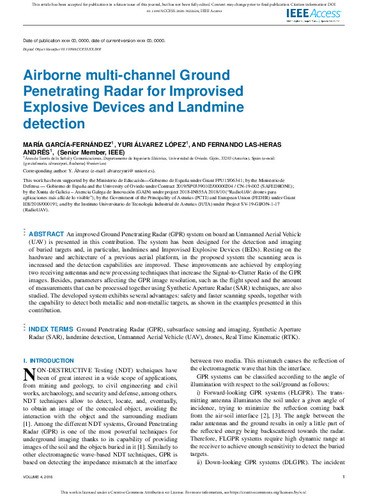Airborne multi-channel Ground Penetrating Radar for Improvised Explosive Devices and Landmine detection
Autor(es) y otros:
Palabra(s) clave:
drones
RPAs
UAVs
georradar
GPR
imaging
telecomunicaciones
synthetic aperture radar
non destructive testing
underground detection
GNSS-RTK
LIDAR
Fecha de publicación:
Editorial:
The Institute of Electrical and Electronic Engineers
Versión del editor:
Citación:
Descripción física:
Resumen:
An improved Ground Penetrating Radar (GPR) system on board an Unmanned Aerial Vehicle (UAV) is presented in this contribution. The system has been designed for the detection and imaging of buried targets and, in particular, landmines and Improvised Explosive Devices (IEDs). Resting on the hardware and architecture of a previous aerial platform, in the proposed system the scanning area is increased and the detection capabilities are improved. These improvements are achieved by employing two receiving antennas and new processing techniques that increase the Signal-to-Clutter Ratio of the GPR images. Besides, parameters affecting the GPR image resolution, such as the flight speed and the amount of measurements that can be processed together using Synthetic Aperture Radar (SAR) techniques, are also studied. The developed system exhibits several advantages: safety and faster scanning speeds, together with the capability to detect both metallic and non-metallic targets, as shown in the examples presented in this contribution.
An improved Ground Penetrating Radar (GPR) system on board an Unmanned Aerial Vehicle (UAV) is presented in this contribution. The system has been designed for the detection and imaging of buried targets and, in particular, landmines and Improvised Explosive Devices (IEDs). Resting on the hardware and architecture of a previous aerial platform, in the proposed system the scanning area is increased and the detection capabilities are improved. These improvements are achieved by employing two receiving antennas and new processing techniques that increase the Signal-to-Clutter Ratio of the GPR images. Besides, parameters affecting the GPR image resolution, such as the flight speed and the amount of measurements that can be processed together using Synthetic Aperture Radar (SAR) techniques, are also studied. The developed system exhibits several advantages: safety and faster scanning speeds, together with the capability to detect both metallic and non-metallic targets, as shown in the examples presented in this contribution.
ISSN:
Patrocinado por:
This work has been supported by the Ministerio de Educación—Gobierno de España under Grant FPU15/06341; by the Ministerio de Defensa— Gobierno de España and the University of Oviedo under Contract 2019/SP03390102/00000204 / CN-19-002 (SAFEDRONE); by the Xunta de Galicia – Axencia Galega de Innovación (GAIN) under project 2018-IN855A 2018/10 (“RadioUAV: drones para aplicaciones más allá de lo visible”); by the Government of the Principality of Asturias (PCTI) and European Union (FEDER) under Grant IDI/2018/000191; and by the Instituto Universitario de Tecnología Industrial de Asturias (IUTA) under Project SV-19-GIJON-1-17 (RadioUAV).
Colecciones
Ficheros en el ítem





